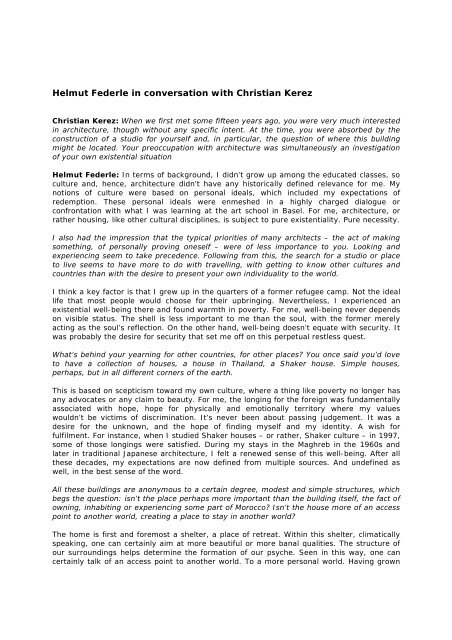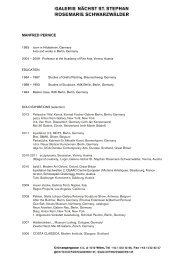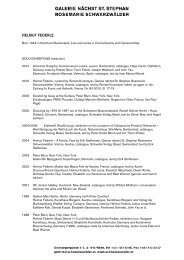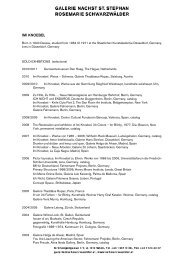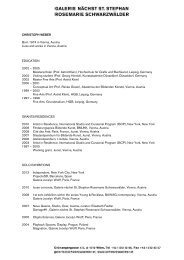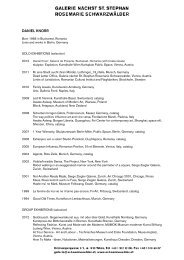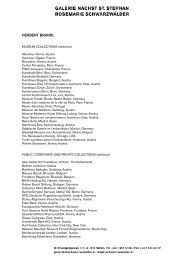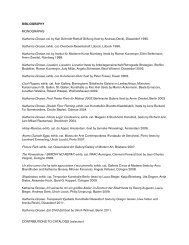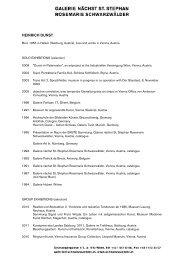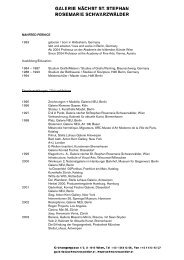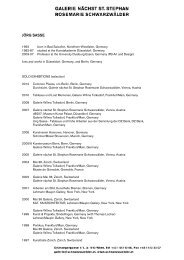Helmut Federle in conversation with Christian Kerez
Helmut Federle in conversation with Christian Kerez
Helmut Federle in conversation with Christian Kerez
You also want an ePaper? Increase the reach of your titles
YUMPU automatically turns print PDFs into web optimized ePapers that Google loves.
<strong>Helmut</strong> <strong>Federle</strong> <strong>in</strong> <strong>conversation</strong> <strong>with</strong> <strong>Christian</strong> <strong>Kerez</strong><br />
<strong>Christian</strong> <strong>Kerez</strong>: When we first met some fifteen years ago, you were very much <strong>in</strong>terested<br />
<strong>in</strong> architecture, though <strong>with</strong>out any specific <strong>in</strong>tent. At the time, you were absorbed by the<br />
construction of a studio for yourself and, <strong>in</strong> particular, the question of where this build<strong>in</strong>g<br />
might be located. Your preoccupation <strong>with</strong> architecture was simultaneously an <strong>in</strong>vestigation<br />
of your own existential situation<br />
<strong>Helmut</strong> <strong>Federle</strong>: In terms of background, I didn’t grow up among the educated classes, so<br />
culture and, hence, architecture didn’t have any historically def<strong>in</strong>ed relevance for me. My<br />
notions of culture were based on personal ideals, which <strong>in</strong>cluded my expectations of<br />
redemption. These personal ideals were enmeshed <strong>in</strong> a highly charged dialogue or<br />
confrontation <strong>with</strong> what I was learn<strong>in</strong>g at the art school <strong>in</strong> Basel. For me, architecture, or<br />
rather hous<strong>in</strong>g, like other cultural discipl<strong>in</strong>es, is subject to pure existentiality. Pure necessity.<br />
I also had the impression that the typical priorities of many architects – the act of mak<strong>in</strong>g<br />
someth<strong>in</strong>g, of personally prov<strong>in</strong>g oneself – were of less importance to you. Look<strong>in</strong>g and<br />
experienc<strong>in</strong>g seem to take precedence. Follow<strong>in</strong>g from this, the search for a studio or place<br />
to live seems to have more to do <strong>with</strong> travell<strong>in</strong>g, <strong>with</strong> gett<strong>in</strong>g to know other cultures and<br />
countries than <strong>with</strong> the desire to present your own <strong>in</strong>dividuality to the world.<br />
I th<strong>in</strong>k a key factor is that I grew up <strong>in</strong> the quarters of a former refugee camp. Not the ideal<br />
life that most people would choose for their upbr<strong>in</strong>g<strong>in</strong>g. Nevertheless, I experienced an<br />
existential well-be<strong>in</strong>g there and found warmth <strong>in</strong> poverty. For me, well-be<strong>in</strong>g never depends<br />
on visible status. The shell is less important to me than the soul, <strong>with</strong> the former merely<br />
act<strong>in</strong>g as the soul’s reflection. On the other hand, well-be<strong>in</strong>g doesn’t equate <strong>with</strong> security. It<br />
was probably the desire for security that set me off on this perpetual restless quest.<br />
What’s beh<strong>in</strong>d your yearn<strong>in</strong>g for other countries, for other places? You once said you’d love<br />
to have a collection of houses, a house <strong>in</strong> Thailand, a Shaker house. Simple houses,<br />
perhaps, but <strong>in</strong> all different corners of the earth.<br />
This is based on scepticism toward my own culture, where a th<strong>in</strong>g like poverty no longer has<br />
any advocates or any claim to beauty. For me, the long<strong>in</strong>g for the foreign was fundamentally<br />
associated <strong>with</strong> hope, hope for physically and emotionally territory where my values<br />
wouldn’t be victims of discrim<strong>in</strong>ation. It’s never been about pass<strong>in</strong>g judgement. It was a<br />
desire for the unknown, and the hope of f<strong>in</strong>d<strong>in</strong>g myself and my identity. A wish for<br />
fulfilment. For <strong>in</strong>stance, when I studied Shaker houses – or rather, Shaker culture – <strong>in</strong> 1997,<br />
some of those long<strong>in</strong>gs were satisfied. Dur<strong>in</strong>g my stays <strong>in</strong> the Maghreb <strong>in</strong> the 1960s and<br />
later <strong>in</strong> traditional Japanese architecture, I felt a renewed sense of this well-be<strong>in</strong>g. After all<br />
these decades, my expectations are now def<strong>in</strong>ed from multiple sources. And undef<strong>in</strong>ed as<br />
well, <strong>in</strong> the best sense of the word.<br />
All these build<strong>in</strong>gs are anonymous to a certa<strong>in</strong> degree, modest and simple structures, which<br />
begs the question: isn’t the place perhaps more important than the build<strong>in</strong>g itself, the fact of<br />
own<strong>in</strong>g, <strong>in</strong>habit<strong>in</strong>g or experienc<strong>in</strong>g some part of Morocco? Isn’t the house more of an access<br />
po<strong>in</strong>t to another world, creat<strong>in</strong>g a place to stay <strong>in</strong> another world?<br />
The home is first and foremost a shelter, a place of retreat. With<strong>in</strong> this shelter, climatically<br />
speak<strong>in</strong>g, one can certa<strong>in</strong>ly aim at more beautiful or more banal qualities. The structure of<br />
our surround<strong>in</strong>gs helps determ<strong>in</strong>e the formation of our psyche. Seen <strong>in</strong> this way, one can<br />
certa<strong>in</strong>ly talk of an access po<strong>in</strong>t to another world. To a more personal world. Hav<strong>in</strong>g grown
up <strong>in</strong> the former refugee camp, I learned that beauty doesn’t depend on a high-culture<br />
context. Today I f<strong>in</strong>d an old build<strong>in</strong>g more fasc<strong>in</strong>at<strong>in</strong>g than new architecture, not least<br />
because the idea of new architecture has become a bourgeois convention.<br />
In the 1980s, architects frequently turned to the field of art, and many of the architects who<br />
currently number among the most <strong>in</strong>fluential, such as Herzog & de Meuron or Frank Gehry,<br />
pursued early collaborations <strong>with</strong> artists. Zaha Hadid found an important reference po<strong>in</strong>t <strong>in</strong><br />
Russian avant-garde pa<strong>in</strong>t<strong>in</strong>g while Rem Koolhaas wrote a screenplay for a feature film.<br />
Dur<strong>in</strong>g this decade, contemporary architecture as a whole was highly engaged <strong>with</strong> art,<br />
where you might say its roots lie. S<strong>in</strong>ce you yourself have worked <strong>with</strong> a good number of<br />
architects, I’d be <strong>in</strong>terested to hear your views on this tendency <strong>in</strong> architecture.<br />
S<strong>in</strong>ce the 1980s, we’ve seen culture tak<strong>in</strong>g the offensive <strong>with</strong> <strong>in</strong>credible drive. In the wake<br />
of the ’68 generation, culture has become more proletarian. It is no longer reserved for an<br />
elite, but has <strong>in</strong>stead spread horizontally. It’s done away <strong>with</strong> hierarchies. This laid the<br />
groundwork for an <strong>in</strong>creas<strong>in</strong>gly aggressive role and speculation <strong>with</strong> other discipl<strong>in</strong>es. Now<br />
as a result, even the smallest village can boast so-called modern architecture, some k<strong>in</strong>d of<br />
art gallery or museum, art activities or an art centre. For me, the creative impulse is an elite<br />
impulse – <strong>in</strong> the best sense of the word – that needn’t be accessible or comprehensible to<br />
all. In this connection, I’d like to cite a l<strong>in</strong>e from the American poet Edward Estl<strong>in</strong> Cumm<strong>in</strong>gs<br />
who wrote, ‘the poems to come are for you and for me and are not for mostpeople.’ I th<strong>in</strong>k<br />
this applies to pa<strong>in</strong>t<strong>in</strong>g as well.<br />
There’s been a shift from the model of masters and pupils to one that assigns the roles of<br />
star and disciple. Couldn’t this model apply to an earlier period as well, <strong>with</strong> the Abstract<br />
Expressionists who pursued emancipation from European predecessors over a great many<br />
years? At nearly the same time, we see the emergence of Pop Art, which is a youth culture.<br />
It seems that youth culture or the culture of cont<strong>in</strong>uous novelty and cont<strong>in</strong>uous <strong>in</strong>vention<br />
and sensation has now ga<strong>in</strong>ed the upper hand. Perhaps it’s also the degree that<br />
differentiates today from the past. Or would you identify a specific date, l<strong>in</strong>k<strong>in</strong>g it to specific<br />
occurrences <strong>in</strong> the art world?<br />
I th<strong>in</strong>k one of the crucial moments is the end of pa<strong>in</strong>t<strong>in</strong>g as an act of creation and the<br />
beg<strong>in</strong>n<strong>in</strong>g of Pop Art, which is a culture of reference. In this regard, I th<strong>in</strong>k the philosophy of<br />
Andy Warhol is disastrous. It essentially ushered <strong>in</strong> the shift from mean<strong>in</strong>g to fame. The<br />
master pr<strong>in</strong>ciple represents mean<strong>in</strong>g; mean<strong>in</strong>g relates to responsibility. Mean<strong>in</strong>g results<br />
from historical <strong>in</strong>tegration <strong>with</strong> its <strong>in</strong>evitable limitation, which should be seen positively.<br />
Fame does not relate to responsibility; fame results from its own offensive behavioural<br />
pattern. This is also a consequence of the mutation of youth music from rebellion to broad<br />
social acceptance. In a certa<strong>in</strong> sense, this is a sign of decadence and a manifestation of<br />
affluence, result<strong>in</strong>g <strong>in</strong> the fact that we have more artists today than farmers.<br />
I also believe that the spectacle makes the form of communication more important than the<br />
content, the way someth<strong>in</strong>g is exhibited. The exhibition has more significance than the<br />
works themselves. This is surely one of the reasons why new media are so widespread <strong>in</strong><br />
art. They’re ideal for imbu<strong>in</strong>g the content of exhibitions <strong>with</strong> character, albeit often a very<br />
fleet<strong>in</strong>g character. Perhaps art has taken on more of a performative character <strong>in</strong> the<br />
aftermath of Pop Art. Could that be a reason why you no longer <strong>in</strong>stall your own exhibitions<br />
or even attend their open<strong>in</strong>gs?<br />
Yes, that’s certa<strong>in</strong>ly a factor. Our media society is ideal for propagat<strong>in</strong>g externals, but<br />
<strong>in</strong>capable of convey<strong>in</strong>g the structure of <strong>in</strong>ner affects. In the past, such affects were often<br />
processed and communicated by scholars. Classical Modernism was a period <strong>in</strong> which tra<strong>in</strong>ed
art historians and art theorists had a say <strong>in</strong> determ<strong>in</strong><strong>in</strong>g the quality of the work. Today the<br />
significance of artists, their fame, no longer depends on art historians or art theorists, but on<br />
the media-based dissem<strong>in</strong>ation of their activities <strong>in</strong> which the masses provide a form of<br />
justification – presumably a result of our highly liberalised democratic form of society – and<br />
become a measure of quality. Someth<strong>in</strong>g that’s consumed and communicated by thousands<br />
of people must be more important than someth<strong>in</strong>g that is debated as significant by serious<br />
art historians. It’s a result of propaganda by f<strong>in</strong>ancially powerful, publicity-seek<strong>in</strong>g<br />
manipulators who <strong>in</strong> many cases have replaced the art theorists.<br />
In his book The Society of the Spectacle, Guy Debord writes that the <strong>in</strong>formation society is<br />
the logical consequence of capitalism <strong>in</strong> which <strong>in</strong>formation becomes a commodity and loses<br />
its critical, reflective character. This applied <strong>in</strong>itially to the media, but now affects art and I<br />
believe architecture as well, which has ga<strong>in</strong>ed unprecedented relevance.<br />
You might recall a talk I gave some years ago <strong>in</strong> which I said that architects who are<br />
unknown, who aren’t famous, fall under the category of applied arts. Architects who are<br />
famous are called artists. That is extremely tell<strong>in</strong>g and confirms my theory that the attention<br />
paid to a work determ<strong>in</strong>es whether it is art or simply a craft or an applied discipl<strong>in</strong>e. This<br />
also expla<strong>in</strong>s why everyone is obsessed <strong>with</strong> be<strong>in</strong>g an artist. It’s reached the po<strong>in</strong>t that even<br />
cooks want to become artists, and hairdressers too, because if they’re not artists, they’re<br />
noth<strong>in</strong>g. The key criterion is whether or not they’re famous. If they’re popular, they’re<br />
famous, and then they’re artists.<br />
There are tendencies for architecture to fall either <strong>in</strong>to one category that’s perhaps more<br />
ak<strong>in</strong> to enterta<strong>in</strong>ment or another, which is ceded to the <strong>in</strong>terests of <strong>in</strong>vestors. The concept of<br />
craftsmanship or a good coherent work is <strong>in</strong>creas<strong>in</strong>gly caught between these extremes. Plus<br />
there’s the phenomenon of architecture be<strong>in</strong>g subject to standards and regulations like<br />
never before. At the same time, artist-architects take on the role of a redeemer, as the only<br />
ones who’ve still got the power to transcend all the legal preord<strong>in</strong>ations, someth<strong>in</strong>g they<br />
manage to achieve by be<strong>in</strong>g on the receiv<strong>in</strong>g end of a certa<strong>in</strong> trust and publicity. It’s a very<br />
complicated and multifaceted situation.<br />
Successful artists or architects can certa<strong>in</strong>ly be exploited for political purposes, be<strong>in</strong>g useful<br />
to society <strong>in</strong>sofar as they justify the <strong>in</strong>vestment that politics makes <strong>in</strong> society. After all,<br />
unlike art, architecture has always been a negotiable dimension. By contrast, artists who<br />
disavow the public sector, which is no longer negotiable today, have no usefulness from a<br />
political po<strong>in</strong>t of view, as such <strong>in</strong>dividuals could never serve to justify expenditure. In this<br />
way, art too has become a negotiable quantity. The political world is a calculat<strong>in</strong>g world, as<br />
opposed to a world <strong>in</strong> flux, which I would hope for and <strong>in</strong> which <strong>in</strong>consistencies and<br />
<strong>in</strong>justices equate to an organic truthfulness. To me, it’s about the truthfulness of feel<strong>in</strong>g,<br />
which br<strong>in</strong>gs to m<strong>in</strong>d the declaration by Malevich that art is materialised feel<strong>in</strong>g. Today<br />
culture is unfortunately a calculat<strong>in</strong>g political world to the core, <strong>in</strong> the process hav<strong>in</strong>g<br />
renounced the fluidity of truthfulness.<br />
You’ve said one of the th<strong>in</strong>gs that l<strong>in</strong>ks you to Modernism is belief <strong>in</strong> a high culture. But I<br />
also th<strong>in</strong>k Modernism is a k<strong>in</strong>d of transitional period, adopt<strong>in</strong>g new production conditions of<br />
build<strong>in</strong>g as its basis while embrac<strong>in</strong>g squarely contradictory ideals from the n<strong>in</strong>eteenth<br />
century, from the Arts and Crafts movement. It did not simply constitute a new beg<strong>in</strong>n<strong>in</strong>g,<br />
but a period of transition. In their search for new build<strong>in</strong>g forms, many architects make<br />
reference to the Middle Ages as well as to the early cultures of Japan or India. Many of the<br />
pieces you’ve collected are over 2,000 years old. Do you see this more as a denial of the<br />
present or perhaps also as a l<strong>in</strong>k to Modernism?
Someth<strong>in</strong>g that’s always preoccupied me is the question of the mean<strong>in</strong>g of be<strong>in</strong>g – why are<br />
we here and where are we go<strong>in</strong>g. Regard<strong>in</strong>g this concern, I placed hope <strong>in</strong> cultures. I<br />
suppose that’s why I began collect<strong>in</strong>g. The validation of be<strong>in</strong>g achieved via ancient relics of<br />
mean<strong>in</strong>gfulness, though this would be <strong>in</strong>conceivable <strong>with</strong>out metaphysics. Into the 1960s,<br />
Modernism was still grappl<strong>in</strong>g <strong>with</strong> these largely spiritual questions of mean<strong>in</strong>g. From this<br />
perspective, I’d count myself as part of Modernism, even if, as you say, Modernism likely<br />
bore <strong>in</strong>herent contradictions that can’t be easily resolved on closer <strong>in</strong>spection. With<br />
Mondrian, for <strong>in</strong>stance, formal developments <strong>in</strong> pa<strong>in</strong>t<strong>in</strong>g were obviously not the crucial<br />
factor, although this is basically the only way his work is now <strong>in</strong>terpreted, mak<strong>in</strong>g it useful<br />
for purposes of propaganda.<br />
I suppose Modernism ultimately cannot be detached from the atrocities of the First and<br />
Second World Wars. And such existential threats <strong>in</strong> the course of history <strong>in</strong>evitably <strong>in</strong>vest<br />
questions of mean<strong>in</strong>g <strong>with</strong> even greater importance.<br />
That’s absolutely correct. Of course, it’s fatal when someone can go unchallenged today <strong>in</strong><br />
say<strong>in</strong>g that externals are more important than <strong>in</strong>ternal feel<strong>in</strong>gs or anxieties, and that <strong>in</strong>ner<br />
concerns are associated <strong>with</strong> kitsch or <strong>with</strong> pathos and therefore considered ridiculous.<br />
Today we are victims of our own arrogance. And it may well be the case that this arrogance<br />
began <strong>in</strong> Modernism. To what extent can a creation breach certa<strong>in</strong> standards <strong>with</strong>out bear<strong>in</strong>g<br />
the resultant consequences? Take the value of break<strong>in</strong>g taboos that once <strong>in</strong>spired<br />
Modernism, ‘To art, its freedom’, a slogan that has acquired such <strong>in</strong>fantile scope today!<br />
People fail to realise that this no longer has anyth<strong>in</strong>g whatsoever to do <strong>with</strong> freedom, but <strong>in</strong><br />
fact has become just the opposite.<br />
A certa<strong>in</strong> suppression is at work whereby we cont<strong>in</strong>ue to have and cause many wars today,<br />
but we aren’t directly affected by them. Provocation tends to have more of an affirm<strong>in</strong>g<br />
element to it. Sexuality and licentious behaviour may have been a means of provocation<br />
back <strong>in</strong> the 1960s. Today, however, you’ll f<strong>in</strong>d it on every commercial TV station. There’s<br />
absolutely noth<strong>in</strong>g exclusionary about it anymore, but rather someth<strong>in</strong>g that signals<br />
affirmation and validation.<br />
That’s correct. I believe the <strong>in</strong>dividual creative personality no longer bears any <strong>in</strong>tr<strong>in</strong>sic<br />
tragedy, result<strong>in</strong>g <strong>in</strong> a tendency toward arrogance and the fact that the entire product, be it<br />
<strong>in</strong> architecture or art, <strong>in</strong> many cases depends solely on reference. And I agree <strong>with</strong> you that<br />
we rema<strong>in</strong> untouched, unaffected, by all the world’s tragedies. Wars are like pop music,<br />
quotidian events <strong>with</strong>out any further relevance or impact. Attempt<strong>in</strong>g to use 9/11 <strong>in</strong> a piece<br />
of art seems easier than try<strong>in</strong>g to imag<strong>in</strong>e be<strong>in</strong>g dead. Mark Rothko, Yasunari Kawabata and<br />
others had to kill themselves to satisfy their own creative impulse.<br />
This has very different consequences as well: youth culture cannot grow old. Many artists<br />
who grow old rema<strong>in</strong> young, so to speak. You're as old as you feel, they say, still feel<strong>in</strong>g like<br />
a thirty-year-old. Along these l<strong>in</strong>es, architecture could be seen as the expression of a<br />
youthful energy. Yet your work appears to develop <strong>in</strong> a completely different direction,<br />
encompass<strong>in</strong>g ag<strong>in</strong>g and existential lows. How do you see your development as a pa<strong>in</strong>ter<br />
over the decades, the way you pursue your work quite unexpectedly and sometimes <strong>with</strong><br />
<strong>in</strong>terruptions?<br />
That’s a difficult question. Actually, I don’t see myself as hav<strong>in</strong>g developed. The restlessness<br />
and hope <strong>in</strong> the 1970s found just as few universal answers as the restlessness and hope of<br />
today. Perhaps I’ve got a different sort of restlessness and hope <strong>in</strong> me today because a lot<br />
of time has been used up. But it’s clearly still about existential feel<strong>in</strong>g. So I haven’t really<br />
made much progress <strong>in</strong> that respect. Nor do I have the satisfaction of look<strong>in</strong>g back on
consolidation. The only consolation is the realisation that my actions have always followed<br />
from organic conditions. Is the young leaf more important than the old, or is the morn<strong>in</strong>g<br />
more beautiful than the even<strong>in</strong>g? I couldn’t say, nor have I any desire to.<br />
At the same time, that’s certa<strong>in</strong>ly a programmatic <strong>in</strong>tention you’ve followed from the very<br />
beg<strong>in</strong>n<strong>in</strong>g, at least to my m<strong>in</strong>d.<br />
I would disagree that it was someth<strong>in</strong>g programmatic. If so, I’d have to admit that I’d failed<br />
because I couldn’t have positioned such a programme <strong>in</strong> society. In that light, I haven’t<br />
failed, but am perhaps simply an anachronism <strong>in</strong> today’s world. No, the mode of <strong>in</strong>vention<br />
has never <strong>in</strong>terested me. I didn’t grow <strong>in</strong>to this behavioural pattern out of social autism. For<br />
me, pa<strong>in</strong>t<strong>in</strong>g a picture is like pett<strong>in</strong>g a cat or trimm<strong>in</strong>g a tree. Many th<strong>in</strong>gs are based on<br />
expectations of beauty. Many th<strong>in</strong>gs happen due to passivity <strong>in</strong> the moment. The fact that<br />
I’ve sometimes been penalised <strong>with</strong> ignorance for this pattern of behaviour is another<br />
chapter.<br />
What I f<strong>in</strong>d so extraord<strong>in</strong>ary <strong>in</strong> your work is the fact that it conta<strong>in</strong>s an emotionality,<br />
someth<strong>in</strong>g that’s been called <strong>in</strong>to question <strong>in</strong> art time and aga<strong>in</strong>. Works that can be<br />
expressed conceptually, through reason, are obviously easier to communicate than works<br />
that are emotional and shaped by personal experience.<br />
In this connection, I’m <strong>in</strong>terested <strong>in</strong> the fact that <strong>in</strong> literature, for <strong>in</strong>stance, this<br />
emotionalisation is no problem whatsoever, but actually someth<strong>in</strong>g expected. It’s about<br />
content and feel<strong>in</strong>g. Art itself has distanced itself from this existential dimension <strong>in</strong> favour of<br />
the strategy of market<strong>in</strong>g as a formal event. These days, I f<strong>in</strong>d myself turn<strong>in</strong>g away from<br />
culture <strong>in</strong> favour of a cultivation of the self, <strong>with</strong> the idea of cultivation as a humanistic<br />
necessity.<br />
Do you see this emotionality, the biographic determ<strong>in</strong>ation of certa<strong>in</strong> works, the love of<br />
ancient cultures and your strong connection to an even older form of culture, to animals, as<br />
a way of repudiat<strong>in</strong>g the current presentation and communication of art?<br />
I can only say that these ancient cultures or, <strong>in</strong> particular, the animal world satisfy me to a<br />
much greater degree than today’s cultural commodities. When I look at architecture and see<br />
a cat next to it, the cat gives me a much greater sense of well-be<strong>in</strong>g than the architecture.<br />
In contemporary culture, I always first see the strategic <strong>in</strong>tentions, based on seek<strong>in</strong>g an<br />
effect and geared toward the necessary strategies of network<strong>in</strong>g. The target is clear.<br />
Everyth<strong>in</strong>g is referential and <strong>in</strong> most cases only serves the maxim of attract<strong>in</strong>g attention,<br />
fulfill<strong>in</strong>g purely economic criteria. Creative impulses are subject to political conventions and<br />
global <strong>in</strong>terests, call<strong>in</strong>g for unconditional solidarity and <strong>in</strong>cestuous tolerance that levels<br />
everyth<strong>in</strong>g. A culture of consensus as a grassroots movement. It has noth<strong>in</strong>g to do <strong>with</strong><br />
be<strong>in</strong>g cultivated. We have long been victims of an <strong>in</strong>formation dictatorship that sires its own<br />
offspr<strong>in</strong>g. This is then called democracy. In response, I praise the beauty and the<br />
truthfulness of the animal world, not least as a metaphor of a fateful archaism.<br />
First published <strong>in</strong> German <strong>in</strong> fair. Zeitung für Kunst und Ästhetik, Vienna, No. 8, I, 2010, pp. 22–24. The <strong>in</strong>terview<br />
was slightly modified and expanded for the present publication.<br />
In: Exhibition catalog EXAMPLE: SWITZERLAND. Unbound<strong>in</strong>g and Cross<strong>in</strong>g Over as Art, ed. by Roman Kurzmeyer<br />
and Friedemann Malsch, Kunstmuseum Liechtenste<strong>in</strong>, HatjeCantz Verlag, Ostfildern/Germany, 2011


